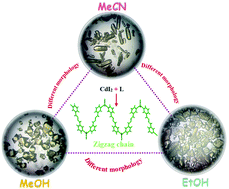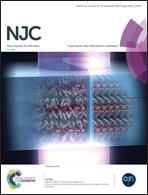The effect of solvent on one-dimensional cadmium coordination polymers†
Abstract
The assembly of 1,4-bis(3-pyridyl)-2,3-diaza-1,3-butadiene (L) with cadmium iodide in different solvent systems was investigated. The results showed the important role played by solvent, as two different one-dimensional coordination polymers were obtained depending on the solvent used. The use of MeOH, EtOH or MeCN as solvent yielded a 1D zigzag chain structural motif of [CdLI2]n (1). Our results showed solvent type to have a dramatic effect on the morphology and crystal habit of the resulting crystalline material of 1. Using DMSO as solvent yielded a 1D sinusoidal wave of [CdLI2(DMSO)2]n (2). We also used dissolution–recrystallization structural transformation (DRST) with DMSO as the solvent to transform 1 directly into 2.



 Please wait while we load your content...
Please wait while we load your content...